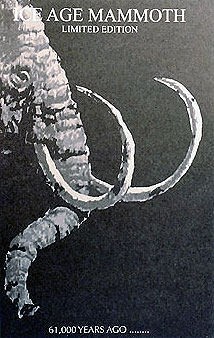| Hersteller: |
Alfred Dunhill |
| Modellbezeichnung: |
Ice Age Mammoth
4202
Black Briar |
| Made in: |
England05
(2005) |
| Größe: |
4 |
| Shape: |
202 Bent |
| Typ: |
Limited Edition |
| Pfeifenkopf: |
Bruyere |
| Mundstück: |
Kautschuk
Fish-tail
Saddle
Wide-bore |
| Bohrung: |
3,5mm oF |
| Applikation: |
Mammut |
| Zustand: |
Neuware |
Mammoth

The Woolly Mammoth
The earliest mammoths originated in southern and eastern Africa approximately 4 million years ago. They migrated north going through three distinctive stages of evolution, from the warm-loving, forest adapted species to the final stage of the recognisable woolly mammoth, which existed in the steppe-tundra of the ice age.
Mammuthus pimigenius (Latin name) comes from the order of mammals called Proboscidea, as do the modern elephant. The name is derived from pro meaning "before" and boskein "to feed".
It had two distinctive spiral curved tusks up to 3.5 meters long. It also had a large shoulder hump, small ears, tail and trunk. Coiled locks of dark hair covered a silky under - fur:
Woolly mammoths could not copy with the rapidly changing environment and increasing human predation toward the close of the last ice age and became extinct about 11,000 years ago.
This Alfred Dunhill Pipe
a group 4 Bent Black Briar
is from a Limited Edition of 300
The mammoth tusk used in the making of the Army Mount and pipe tamper cap has come from an animal that was discovered in the Siberian Tundra.

Using the scientific technique of radiocarbon dating, at one of Englands leading Universities, and a Schreger test, it has been identified as coming from a mammoth that would have roamed the Earth some 61,000 years ago.